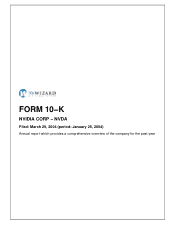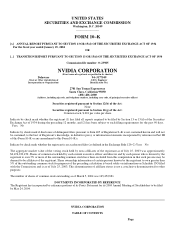NVIDIA 2004 Annual Report Download - page 6
Download and view the complete annual report
Please find page 6 of the 2004 NVIDIA annual report below. You can navigate through the pages in the report by either clicking on the pages listed below, or by using the keyword search tool below to find specific information within the annual report.
GeForce, Go and Quadro.
GeForce. The GeForce family represents our desktop GPUs and includes the GeForce FX, GeForce4 and GeForce2. Our most
advanced GPU family is the GeForce FX series. Introduced in November 2002, the GeForce FX architecture is our first fully
programmable cinematic GPU and is also our first to be manufactured using 0.13−micron process technology. Our GeForce FX 5950
GPU is one of the semiconductor industry’s most complex application specific integrated circuits, or ASICs. The GeForce FX 5950
GPU contains over 135 million transistors and reaches processor clock speeds up to 500 megahertz, or MHz, and memory clock
speeds up to 1 gigahertz, or GHz. The GeForce FX family is designed for the enthusiast, performance and mainstream consumer
segments. The GeForce2 and GeForce4 are designed to deliver a balance of performance and features for the value and low−cost PC
segments.
Go. The GeForce Go and Quadro Go families represent our notebook GPUs and include the GeForce FX Go, GeForce4 Go, GeForce2
Go, QuadroFX Go, Quadro4 Go and Quadro2 Go GPUs. These GPUs are designed to deliver desktop graphics performance and
features for multiple notebook configurations from desktop replacements, performance notebooks and thin−and−lights to mobile
workstations. The GeForce Go products are designed to serve the needs of both corporate and consumer users. The Quadro Go
products are designed to serve the needs of workstation professionals in the area of product design and digital content creation.
Quadro. NVIDIA’s Quadro branded products are robust, high−performance workstation solutions for the professional user that are
available for the high−end, mid−range, entry−level and multi−display product lines. The NVIDIA Quadro family, which consists of
the Quadro FX, Quadro4 and the Quadro NVS workstation solutions are designed to meet the needs of a number of workstation
applications such as industrial product design, digital content creation, non−linear video editing, scientific and financial visualization,
general purpose business and financial trading. NVIDIA Quadro products are fully certified by several software developers for all
professional workstation applications, and are designed to deliver the graphics performance and precision required by professional
applications.
2
MCPs. Our MCP product family, known as nForce, supports desktop PCs, notebook PCs and professional workstations.
nForce. The nForce family represents our MCPs for AMD−based desktop, notebook and workstation PCs and includes the nForce2
and nForce3. We define a MCP as a single−chip or chipset that can off−load system functions, such as audio processing and network
communications, and perform these operations independently from the host central processing unit, or CPU. The nForce2 integrates a
comprehensive set of multimedia capabilities, such as two−dimensional, or 2D, three−dimensional, or 3D, digital video disc, or DVD,
high−definition television, or HDTV, Dolby Digital audio playback and fast broadband and networking communications. nForce2 is a
two−chip solution, which includes either a System Platform Processor, or SPP, or an Integrated Graphics Processor, or IGP, combined
with a MCP. The nForce2 family is designed to be compatible with AMD’s AthlonXP and Duron microprocessors. The nForce2
configuration is determined by the OEM or system builder. The nForce3 family is a single−chip MCP, designed to be compatible with
AMD Athlon64, Athlon 64 FX and Opteron 64−bit CPUs. nForce3 products which consist of the nForce3, nForce3 Professional and
nForce3 Go, are designed to complement the latest 64−bit CPUs while delivering innovative technologies for networking, storage and
system performance.
UMPs. Our UMP product family, known as GoForce, supports handheld personal digital assistants, or PDAs, and cellular phones.
GoForce. The GoForce family represents our UMPs for a wide range of cellular and handheld devices. The GoForce 2100 is one of
the first UMPs to offer hardware acceleration engines for 2D graphics to manufacturers that support liquid crystal display, or LCD,
screen resolutions up to 320 x 240 pixels. The GoForce 2150 offers a host of advanced features for cellular phones and PDAs,
including support for 1.3−megapixel image capture, accelerated graphics for gaming, and motion Joint Photographic Experts Group,
or JPEG, capture and playback. Using dedicated hardware accelerator engines, the GoForce 2150 delivers high performance
multimedia applications and drives high−resolution displays, while extending handheld battery life through a variety of unique power
management techniques.
Xbox. Our Xbox platform processor supports Microsoft’s Xbox video game system. The Xbox platform processor features
dual−processing architecture, which includes NVIDIA’s GPU designed specifically for the Xbox, or XGPU, and a MCP to power the
Xbox’s standout graphics, audio and networking capabilities. The XGPU is a programmable 3D processor that contains more that 60
million transistors. The amount of computing horsepower is dedicated to one goal – to create stunning, never−before−seen imagery.
The MCP is based on two powerful digital signal processors with 4 billion operations per second dedicated to 3D audio and network
processing. The MCP performs the processing for the broadband networking functions and high−speed peripherals.
Our Strategy
We design our GPUs, MCPs and UMPs to enable OEMs, original design manufacturers, or ODMs, system builders, motherboard and
add−in board manufacturers to build award−winning products by delivering state−of−the−art interactive 3D graphics, audio,
networking and communications capability, while maintaining affordable prices. We believe that by developing 3D graphics and
media communications solutions that provide superior performance and address the key requirements of the PC and handheld
segments, we will accelerate the adoption of high−definition digital media platforms and devices throughout these segments. We



















